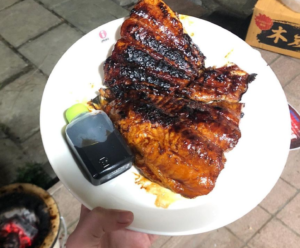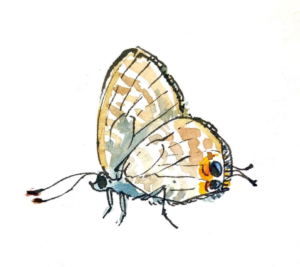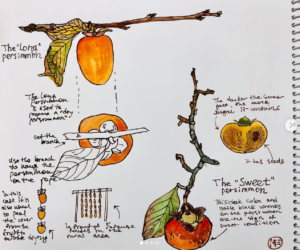Mariia Ermilova Terada shows us how to nature journal biocultural diversity. Not only does she nature journal in three languages but she also incorporates the human-nature connection into her pages. In contrast, most nature journalers today omit this relationship. For example, I often choose nature subjects where I cannot see the human interaction. I frequently exclude hikers, benches, telephone poles from my landscape paintings. Another example is that I rarely nature journal my garden, my salad, or the other aspects of nature my life is directly dependent on.
In addition, we talk about Mariia’s studies, her love of frogs, fabric arts, and the role nature journaling can play in making the world a better place. Don’t miss the lightning round!
How to Nature Journal Your Breakfast
Did you nature journal the plants and animals that you ate for breakfast today? What about the plants or animals that made your clothes? Have you ever included the indigenous names for plants or animals on your page? If nature journaling is supposed to connect us more to nature why do we often avoid the subjects we are most closely connected to?

In the above example we can see how Mariia applies nature journaling to an everyday scene. Her neighbor caught a fish and is cooking it. This nature journal page captures that subsistence relationship. In addition she gives the name of the fish in three languages and points out how it is an invasive species. The combination of comic, recipe, and species profile give this page a biocultural significance.  In contrast, Mariia could have just nature journaled a random butterfly. “What’s wrong with nature journaling a random butterfly?” In fact, there is nothing wrong with choosing a subject just because of an aesthetic interest. But let’s be self aware. Why don’t we nature journal what we eat?
In contrast, Mariia could have just nature journaled a random butterfly. “What’s wrong with nature journaling a random butterfly?” In fact, there is nothing wrong with choosing a subject just because of an aesthetic interest. But let’s be self aware. Why don’t we nature journal what we eat?
How to Nature Journal Biocultural Diversity
- First, be curious about local traditional knowledge about nature in the area where you are. What culture has been living there? What was their relationship to the plants and animals and landscapes you are drawing? Is there a way you can recognize and incorporate some of that into your journal? However, be aware of the issue of cultural appropriation.
- Second, be curious about cultural context. Even the magnolia in your garden, the chicken in your soup, or your house cat have a cultural
 context. Even a quick search on google could find some cool background. What if you included a map, names in other languages, or historic references next to that sketch of your feline or flower?
context. Even a quick search on google could find some cool background. What if you included a map, names in other languages, or historic references next to that sketch of your feline or flower? - Finally, what are some biocultural connections from your own life? You can also try to nature journal some of the aspects of your own life that are connected to nature. What plants, animals, fungi, minerals etc do you relate to on a daily basis?
See more of Mariia’s work: https://taplink.cc/mariia_ermilova_terada
Just getting started with nature journaling?
Need more tips? If so, check out this post. It will walk you through how to nature journal in 10 steps.
Need help choosing nature journaling supplies? Check out Nature Journaling Supplies: What You Need and What You Do Not

 context. Even a quick search on google could find some cool background. What if you included a map, names in other languages, or historic references next to that sketch of your feline or flower?
context. Even a quick search on google could find some cool background. What if you included a map, names in other languages, or historic references next to that sketch of your feline or flower?